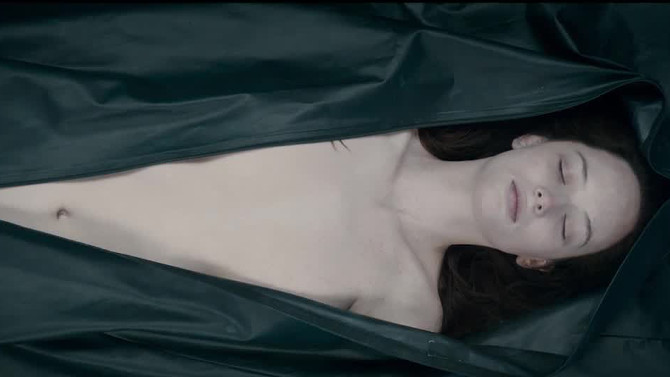Perhaps the beginnings of a new sub-genre of horror, André Øvredal’s 2016 offering, The Autopsy of Jane Doe, follows up the similarly set The Corpse of Anna Fritz with another claustrophobic, morgue-centric tale. Perhaps we could drop the ‘rue’ from the classic Edgar Allen Poe tale and call them “Murders in the Morgue”.
With a cleverly concocted set up, the first half of the film toys with us, introducing not only the main characters, but the little threads that will come into play later on. Beginning with a gruesome murder scene (dead bodies are scattered throughout a house), Sheriff Burke (Michael McElhatton – Roose Bolton in Game of Thrones) is stymied when he discovers a half buried body of a young woman – the only one with not a thing wrong with it (seemingly). In a bizarre twist, it seems like those murdered were trying to escape the abode – and that no one broke in.
Needing answers, the Sheriff promptly transports the corpse to the local morgue run by Tommy Tilden (Brian Cox). Almost entirely set in the morgue – it has been designed in the cellar of a Victorian-style farmhouse which has been in the Tilden family for multiple generations, and Tommy’s son Austin (Emile Hirsch) has found himself following the same line – though he is trying to work up the courage to tell his father that he is leaving the business. In a loving relationship with his girlfriend Emma (Ophelia Lovibond), she is prodding her beau to finally open up to him.
Instead of heading out for his date with Emma, Austin decides to stay back and help his father complete the autopsy of the mysterious maiden (rescheduling their engagement for 11 P.M.). As they delve into their work, they discover many unusual and unexpected finds. Though her perfect exterior is fascinating, it is even more perplexing when they realize that the interior of her body is quite the opposite. As things start to turn hairy, a major storm settles in. What will the father and son team unearth? Will they be able to survive the strange occurrences that begin to arise?
Foreshadowing the scares, the setting plays a major part. Feeling somewhat like modern catacombs, the only two ways in or out of the basement are through a rickety old elevator or by way of giant steel doors where the wooden cellar entry once was. As the family has been in business for over one hundred years, they still utilize some traditional methods – for instance, they tie a bell around the ankle of the corpses. . . an old-fashioned warning system in case the person inside the drawer is not dead. The father and son duo also like to listen to the local radio station while they work (though when the ominously used 50s song “Open Up Your Heart and Let The Sun Shine In” crackles through the air waves, the audience knows something is not right). And, their pesky old cat enjoys skulking through the air vents. There is also a very noticeable camera shot (used more than once) that gives us a look down the hall by way of the convex security mirror. It is these things, mixed with Øvredal’s direction and the character driven story, that creates a palpable, confining atmosphere, even when we do not know what is going to happen.
The last few years have brought a number of quality horror films (many of them independent) featuring richly drawn characters, and this one is no different. Cox channels the wise old coroner, having seen almost everything in his day. Still in many ways haunted by the death of his wife, he internalizes the pain and works through it, spending long hours on the job. Hirsch’s Austin, the much less experienced of the two, is much more curious – still wanting to know the why, instead of just focussing on the question of how these people died. By fusing these two very differing perspectives together, they are better able to meet the challenges that are going to come in on the gurney with Jane Doe. Olwen Kelly (Jane Doe) also deserves credit for being such a realistic corpse.
Pulling from multiple sources, the cramped, restricted location will bring to mind a plethora of horror greats, such as Alien and The Shining, along with more modern films like Don’t Breathe and 1408 – which many might also draw parallels to for its use of a song that also surprisingly induces horrific shivers – “We’ve Only Just Begun” by The Carpenters. Obviously, it also has some similarities to the above mentioned The Corpse of Anna Fritz, though that picture is more grounded in some sort of reality compared to this more supernaturally driven narrative.
With an intriguing development (that you will likely pick up on before the main characters – especially if you watch a television series like Supernatural), the first hour shines brighter than the final twenty minutes, though despite that, it is still an atmospheric, horror-filled experience with a decently satisfying ending. Transporting us inside the morgue, the viewer must not only deal with the morbidity of an autopsy, but must also be on guard for jump scares and the things that go bump in the night. Its mood is so palpable that you too feel like you are confined in the lightless cement morgue that is their basement. It is this that is perhaps the most impressive. . . that, despite the possibility of going for straight-forward gore horror, most of the scares are constructed by the talent that comes from quality cinematography (by Roman Osin), perfectly placed camera locations, a quality score (by Danny Bensi and Saunder Jurriaans), superlative acting and a carefully built mood. So, make an incision and dissect this bewitching horror flick, it might make you go toes up in fright.

